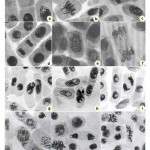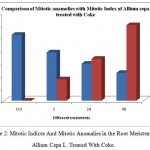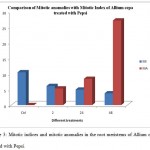How to Cite | Publication History | PlumX Article Matrix
Duration Dependent Mutagenic Study of Cola Drinks on Allium Cepa L.
Cordilea Hannah1, E. Joyce Sudandara Priya2* and Anu Mammen2
1Department of Plant Biology and Plant Biotechnology, Women’s Christian College, Chennai - 600 006 (India). 2Department of Plant Biology and Plant Biotechnology, Madras Christian College, Chennai - 600 059 (India).
ABSTRACT: The mutagenecity of carbonated cola drinks were investigated using the root chromosome assay. Treatment with cola drinks for 2, 24 & 48 hours showed mito-inhibitory effect. The total chromosomal aberrations increased significantly with prolonged exposures, indicating duration dependant cytostatic and clastogenic properties of Coke and Pepsi.
KEYWORDS: Carbonated cola drinks; onion root meristem; mutagenicity.
Download this article as:| Copy the following to cite this article: Hannah C, Priya E. J. S, Mammen A. Duration Dependent Mutagenic Study of Cola Drinks on Allium Cepa L. Biosci Biotech Res Asia 2010;7(2) |
| Copy the following to cite this URL: Hannah C, Priya E. J. S, Mammen A. Duration Dependent Mutagenic Study of Cola Drinks on Allium Cepa L. Biosci Biotech Res Asia 2010;7(2). Available from:https://www.biotech-asia.org/? p=9289 |
Introduction
Carbonated drinks broke its way as becoming part of human consumption in the early 19th century. Although sources of empty calories, they have replaced healthy fruit juices and are the dietary staple of the youth today. Recent findings by the Center for Science and Environment claimed that tests revealed the presence of four extremely toxic pesticides and insecticides such as Chlorpyrifos, Dichloro-diphenly-trichloroethane (DDT), Lindane and Malathion levels higher than the European Economic Community (EEC) standards (1). The growing awareness that chemicals present in the edible products causes deleterious, heritable change in humans without immediate toxic effect has given impetus to study the effect of carbonated cola drinks on plant systems (2). Hence, this study was conducted to investigate any possible mutagenic and chromotoxic effect Coke and Pepsi may have on the cell cycle and chromosomes.
Materials and Method
The root tips of Allium cepa were fixed and stained as per Haematoxylin squash method (3). Mitotic indices were recorded from root meristems treated individually with the two test chemicals Coke and Pepsi for 2, 24 & 48 hrs and control samples examining a minimum of 2,000 nuclei per root involving 6 root tips from 3 bulbs two each. The frequency of division was calculated following Wilner and Soares method (4). The frequency of chromosomal anomalies were determined and classified on the basis of Buckton and Evans (5). The mitotic irregularities like break, anaphasic bridge, lagging chromosome, abortive anaphase, multipolar anaphase, star anaphase, ring metaphase, prophasic, metaphasic, anaphasic and telophasic clumps were screened. ANOVA 2-tailed t-test (AddIn- StatistiXL; MS Excel, 2007) was carried out to bring out the probability of significant difference (Level of significance P<0.001) among Coke and Pepsi when compared to the control.
Results
The mitotic index of cells treated with Coke showed the values 7.68%, 5.89% & 4.43% in 2, 24, 48 hours durations respectively (figure 2). The cells showed reduction in the frequency of division when compared to control 10.49% (distilled water). Among the different treatments, the t-test analysis revealed high significant reduction in the mitotic index at 24 & 48 hours treatments. However, with specific reference to the different stages of mitosis, prophase and anaphase stages were significantly reduced (table 1). The mitotic indices decreased drastically in Pepsi treated root samples at all durations compared to control samples (figure 3). The decrease in the divisional frequency was observed to be duration dependent. The short duration treatment (2 hours) brought about the reduction in mitotic index (6.1%) when compared to the control. Prolonged exposure of the root meristems to the test chemical brought about a higher probability of significant mitotic reduction (table 2). Pepsi cola significantly reduced prophase and anaphase stages of mitotic division at all the three durations of exposure. Figures 2 and 3 show that in both soft drinks tested at 2, 24 & 48 hours treatment brought about a significant reduction in the mitotic indices.
Table 1: Mitotic indices in the root meristems of Allium cepa L. treated with Coke
| Duration of treatment | Total No. of cells scored | Total no. of cells in division
|
MITOTIC INDEX
(Mean ± SE) |
*P < 0.001 |
|||
| Prophase | Metaphase | Anaphase | Telophase | ||||
| 2 | 2014 | 142 | 7.688 ± 0.359 | 0.05 | 0.11 | 0.003 | 0.047 |
| 24 | 2006 | 105 | 5.89 ± 0.214 | 0 | 0.066 | 0 | 0.024 |
| 48 | 2006 | 76 | 4.432 ± 0.101 | 0 | 0.013 | 0 | 0.017 |
Table 2: Mitotic indices in the root meristems of Allium cepa L. treated with Pepsi.
| Duration of treatment | Total no. of cells scored | Total no. of cells in division | Mitotic Index
(Mean ± SE) |
*P < 0.001 | |||
| Prophase | Metaphase | Anaphase | Telophase | ||||
| 2 | 2010 | 101 | 6.102 ± 0.209 | 0 | 0.055 | 0.001 | 0.035 |
| 24 | 2009 | 101 | 4.943 ± 0.688 | 0 | 0.055 | 0.001 | 0.035 |
| 48 | 2006 | 46 | 3.765 ± 0.269 | 0 | 0.024 | 0 | 0.022 |
The carbonated cola drinks induced various chromosomal abnormalities such as clump, fragment, laggard, bridge, ring, break, tri and multipolar anaphase, C-metaphase, disturbed and abortive anaphase (figure 1). The test chemical (Coke) increased the incidence of anomalies in the treated cells and higher frequencies of aberrations were found during longer exposure (48 hours). Distinct duration dependant increases in chromosomal anomalies were observed (3.39%, 6.68%, 12.03% at 2, 24& 48 hours respectively) when compared to the control samples. The induction of clumps was found to be higher during all exposures (figure 2). Pepsi cola induced structural aberrations of chromosomes such as prophasic and metaphasic clumps, lags, anaphasic bridges, etc. (figure 1). Higher frequency chromosomal aberrations were observed during 48 hours treatment (27.07%). The frequencies of occurrence of clumps were of higher frequency in all durations when compared to other anomalies (table 4). The values of mitotic anomalies in root meristem of onion following treatment with Coke and Pepsi for all the three durations along with the control are presented in tables 3 & 4.
 |
Figure 1: Root meristems of Allium cepa L. showing normal mitotic stages and various mitotic anomalies.
|
 |
Figure 2: Mitotic indices and mitotic anomalies in the root meristems of Allium cepa L. treated with coke.
|
 |
Figure 2: Mitotic indices and mitotic anomalies in the root meristems of Allium cepa L. treated with coke.
|
Table 3: Mitotic anomalies induced by Coke in the root meristems of Allium cepa L.
|
S. No |
Duration of treatment in hours |
Total no. of cells scored N |
No. of aberrant cells |
Mitotic Anomalies (%) MEAN±SE |
Types & % of Mitotic Anomalies | ||||||||||||
|
C |
F |
L |
B |
R |
Br |
TA |
MA |
DA |
C-META |
Pul |
MF |
AA |
|||||
| 1
|
2 | 142 | 5 | 3.39±0.622 | 28.6 | – | 14.3 | 10.7 | – | 14.3 | 3.7 | 10.7 | – | 10.7 | – | – | 7 |
| 2 | 24 | 105 | 7 | 6.67±0.558 | 42.8 | 4.8 | 7.1 | 16.7 | 2.4 | 19 | 4.8 | – | 2.4 | – | – | – | – |
| 3 | 48 | 76 | 9 | 12.03±1.22 | 50 | 5.6 | 7.4 | 5.6 | – | 5.6 | 7.4 | – | 5.6 | 1.8 | 7.4 | 3.6 | – |
| 4 | Control
|
1266 | 0 | 0 | – | – | – | – | – | – | – | – | – | – | – | – | – |
TABLE 4: Mitotic anomalies induced by Pepsi in the root meristems of Allium cepa L.
|
S. No |
Duration of treatment in hours |
Total no. of cells scored N |
No. of aberrant cells |
Mitotic Anomalies (%) MEAN±S.E |
Types & % of Mitotic Anomalies | ||||||||||||
|
C |
F |
L |
B |
R |
Br |
TA |
MA |
DA |
C-META |
Pul |
MF |
AA |
|||||
| 1 | 2 | 101 | 5 | 5.31±0.47 | 31.4 | 12.5 | 18.8 | – | – | 6.3 | 12.5 | – | – | – | 12.5 | 3 | 3 |
| 2 | 24 | 73 | 9 | 8.39±0.46 | 39 | 3.9 | 9.8 | 11.8 | 4 | 7.8 | 13.8 | 4 | 2 | – | 3.9 | – | – |
| 3 | 48 | 46 | 12 | 27.07±2.98 | 54 | 10.8 | 5.4 | 4 | – | 8 | 4.1 | 1.5 | – | – | 6.8 | 5.4 | – |
| 4 | Control
|
1266 | 0 | 0 | – | – | – | – | – | – | – | – | – | – | – | – | – |
Discussion
The present investigation on Coke and Pepsi treated cells showed that the soft drinks had an immediate toxic effect on the dividing cells as it drastically reduced the mitotic index at 2 hours exposure. The treatment at 2, 24 & 48 hrs showed a duration dependant decline in the frequency of the diving cells and elevated number of aberrant cells, confirming the observations of Pandey et al. (6) and Priya et al. (7) of malathion on Allium root meristems which is one of the chemical contaminant known to be present in Coke and Pepsi. The mitotoxic effect of the test chemicals may be attributed to the suppression of DNA synthesis during the interphase stage of the cell cycle (8). The total rate of aberrations increased as the treatment prolonged. The carbonated cola drinks induced various chromosomal abnormalities such as clump, fragment, laggard, bridge, ring, break, tri and multipolar anaphase, C-metaphase, disturbed and abortive anaphase. Bayoumi et al. (9) reported similar incidence of anomalies on rat cells treated with insecticide chlorpyrifos methyl (organophosphorus). Among them clumps were frequently observed. Clump induction during all the mitotic stages was due to sticky chromosome (1). The stickiness of the chromosome is a result of the interaction of the cola drinks with the DNA, leading to the cross linkage of the DNA proteins and improper folding of the chromosomes (10). The C-metaphase is produced due to the inhibition of spindle fibre formation and hence failure of the chromosomes to reach the poles (11). Spindle fibre depolymerisation results in abortive and disturbed anaphase (12). Kaur and Grover (13), reported that the failure of the broken chromosome to recombine and move toward the poles has led to the occurrence of chromosomal fragments and lags. He also observed the improper spindle fibre formation produced cells with abnormal chromosomal orientation at the poles.
It could be concluded that Pepsi and Coke brought about an immediate mito-inhibitory effect and hence are genotoxic chemicals. The carbonated drinks induced duration dependent increase in mitotic anomalies and induced structural aberration of chromosomes. The test chemicals were found to be both mitotoxic and genotoxic. It could be concluded that the outcome of the study will help ensure proper food safety measures.
Acknowledgements
We are grateful to Head of the Department of Plant Biology and Plant Biotechnology, Madras Christian College for providing us with the necessary laboratory facilities to carry out the research successfully. We are also thankful to Mr. Senthilkumar U, School of Ecology and Conservation, GKVK, Bangalore for extending his help in statistical analysis.
References
- Ram Shanker Singh and Singh R.R., J. Appl. Biosci., 31 (2), 166-169 (2005).
- Auerbach, C. and Robson J.M., Nature, 157, 302 (1946).
- Marimuthu K.M. and Subramaniam M.K., Sci., 29, 482-483 (1960).
- Wilner J.L. and Soares E.R., Mutagenesis, 2, 35-42 (1980).
- Buckton K.E. and Evans H.J., In: World Health Organisation. Geneva (1973).
- Pandey R. K., Shukla R. and Datta S. K., Cytologia, 59, 419-422 (1994).
- Priya E.J.S.,Vivekanandan O.S. and Gowrishankar, Indian Journal of Experimental Biology, 34, 320-324 (1996).
- Chand S. and Roy S.C., Biol. Plant (Parha), 23, 198-202(1981).
- Bayoumi Q.C., Abdel-Azeez, Khilo A., Fikey A.A. and Hemeda S.A., Veterinary medical journal – Giza, 43, 115-122 (1995).
- Amin, A. W., Pakistan Journal of Biological Sciences, 5(2), 184 – 188 (2002).
- Amer, S.M and Ali, E.M., Cytologia, 51, 21-25(1986).
- Mederios M.D.C. and Takahashi C.S., Cytologia, 52, 255-259 (1987).
- Kaur P. and Grover I.S., Cytologia, 50, 187-197(1985).

This work is licensed under a Creative Commons Attribution 4.0 International License.





